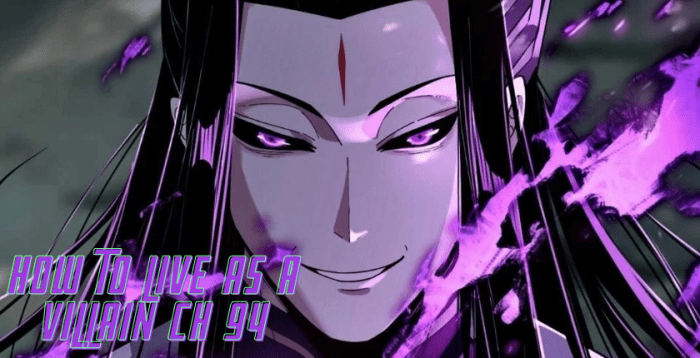
How to live as a villain ch 94 – Step into the enigmatic world of villainy with “How to Live as a Villain Ch. 94.” This chapter delves into the intricate tapestry of evil, exploring the ethical complexities, strategies for success, and profound impact of villainous actions.
From the motivations that drive villains to the alliances they forge, this chapter provides a comprehensive guide to the art of villainy. Prepare to unravel the secrets of iconic villains and discover the lasting legacy they leave behind.
Villainy and Morality: How To Live As A Villain Ch 94
Villainy, the epitome of malevolence, often conjures images of heartless evildoers reveling in chaos. Yet, beneath the sinister facade, a complex tapestry of motivations and justifications weaves through the psyche of these enigmatic characters.
Villains, like their virtuous counterparts, are not immune to the pangs of conscience. They may grapple with the ethical implications of their actions, seeking twisted justifications or deluding themselves into believing their heinous deeds serve a greater purpose. Some villains may adhere to warped moral codes, believing their actions are necessary for the greater good or to right perceived wrongs.
Villains with Complex Moral Codes
- Thanos(Marvel Comics): Driven by a twisted belief in resource scarcity, Thanos seeks to eliminate half of all life in the universe to restore balance.
- Magneto(X-Men): A Holocaust survivor, Magneto believes in the supremacy of mutants and uses violent means to protect them from perceived human oppression.
li> Darth Vader(Star Wars): Once a noble Jedi Knight, Vader succumbs to the dark side after witnessing the corruption and tyranny of the Republic. He believes his actions are necessary to bring order to the galaxy.
Strategies for Villainous Success

Villains who achieve their goals do so through cunning, strategy, and unwavering determination. They possess a deep understanding of their own strengths and weaknesses, and they use this knowledge to their advantage. They are also able to adapt to changing circumstances and to exploit the weaknesses of their enemies.
One of the most important strategies for villainous success is to have a clear goal in mind. What do you want to achieve? Once you know what you want, you can develop a plan to achieve it. This plan should be flexible enough to adapt to changing circumstances, but it should also be detailed enough to provide you with a roadmap for success.
How to live as a villain ch 94. In this chapter, we see the villainous protagonist continue their journey of villainy. They face new challenges and obstacles, but they remain determined to achieve their goals. You can read the full chapter here . How to live as a villain ch 94.
Psychological Traits and Abilities
In addition to strategic planning, villains who succeed also possess certain psychological traits and abilities. These traits include:
- Intelligence:Villains who succeed are often highly intelligent. They are able to think strategically and to come up with creative solutions to problems.
- Charisma:Villains who succeed are often charismatic. They are able to inspire loyalty in their followers and to persuade others to do their bidding.
- Ruthlessness:Villains who succeed are often ruthless. They are not afraid to do whatever it takes to achieve their goals, even if it means hurting others.
Villainous Relationships and Alliances
In the murky underworld of villainy, relationships and alliances play a pivotal role in shaping the landscape of evil. From treacherous partnerships to bitter rivalries, the dynamics between villains are as complex and multifaceted as the schemes they concoct.
Yo, check it, how to live as a villain ch 94 is off the chain. It’s all about how to live as a villain ch 94 and do it right. The secrets of how to live as a villain ch 94 are revealed in this epic chapter.
Don’t miss out, click how to live as a villain ch 94 now!
Forming alliances with other villains can provide a multitude of benefits. It allows them to pool their resources, share knowledge and skills, and increase their chances of success in achieving their nefarious goals. However, these alliances are often fraught with challenges, as trust is a rare commodity among the wicked.
Iconic Villainous Partnerships
History is replete with legendary villainous partnerships that have left an indelible mark on the annals of evil. The Joker and Harley Quinn, a twisted love affair marked by chaos and madness; Lex Luthor and Brainiac, a formidable alliance of intellect and technology; and Sauron and Saruman, the Dark Lord and his treacherous lieutenant, are just a few examples of iconic villainous duos.
Rivalries and Betrayal
While alliances can be advantageous, rivalries are equally prevalent in the villainous realm. Competition for power, resources, or simply the thrill of outmaneuvering an opponent can drive villains to engage in bitter feuds. These rivalries often lead to betrayals, backstabbing, and a never-ending cycle of revenge.
The Impact of Villainous Actions
Villainous actions can have profound and far-reaching consequences, impacting not only the immediate victims but also society as a whole. These actions often involve causing harm, destruction, or disruption, which can lead to a range of negative outcomes.
Yo, check it, you wanna know how to be a straight-up villain? Head over to how to live as a villain ch 94 . That’s right, the ultimate guide to being a baddie. From evil plans to wicked outfits, they got you covered.
So, if you’re ready to embrace your dark side, click that link and start scheming like a pro!
Consequences for Society
- Social unrest and chaos:Villainous actions can destabilize society, creating fear, mistrust, and chaos. This can lead to a breakdown of law and order, making it difficult for people to live safely and securely.
- Economic damage:Villainous actions can disrupt economic activity, causing job losses, business closures, and a decline in overall prosperity. This can have a devastating impact on communities and individuals.
- Environmental destruction:Villains may engage in actions that harm the environment, such as polluting waterways, destroying forests, or releasing hazardous chemicals. This can have long-term consequences for human health and the well-being of the planet.
Consequences for Individuals
- Physical and emotional harm:Villainous actions can cause physical injuries, psychological trauma, or even death. Victims may experience lasting physical and emotional scars.
- Loss of trust and respect:Villains often betray the trust of those around them, causing feelings of betrayal, anger, and resentment. This can make it difficult for villains to form meaningful relationships or build a sense of community.
- Isolation and alienation:Villains may find themselves isolated and alienated from society as a result of their actions. They may be shunned or ostracized by others, making it difficult to find acceptance or support.
Moral and Ethical Implications
Villainous actions raise important moral and ethical questions. Causing harm or destruction for personal gain or gratification is generally considered wrong. Villains may justify their actions by claiming they are fighting for a greater good or that their victims deserve punishment.
However, these justifications often fail to hold up under scrutiny.
Villains who engage in truly heinous acts may cross a line that is difficult to return from. Their actions may become so morally repugnant that it becomes impossible for them to be forgiven or redeemed.
Potential for Redemption or Change
Despite the negative consequences of villainous actions, there is always the potential for redemption or change. Even the most hardened villains may experience a moment of clarity or a change of heart. If they are willing to confront their past actions and take responsibility for their mistakes, they may be able to find a path to redemption.
However, redemption is not always possible or easy. Villains who have committed truly heinous crimes may find it difficult to atone for their actions. They may be haunted by their past deeds for the rest of their lives.
Villainous Legacy and Impact

Villains have left an indelible mark on history and popular culture, inspiring fear, admiration, or a complex mix of both. Their actions and motivations have shaped narratives, influenced societal perceptions, and sparked countless debates.
Throughout history, villains have played a pivotal role in shaping events. From ancient tyrants like Nero to modern-day warlords, they have inflicted unimaginable suffering and terror. Yet, some villains have also garnered a strange kind of admiration, even sympathy, due to their charisma, intelligence, or perceived underdog status.
Iconic Villains in Literature, Film, and Television, How to live as a villain ch 94
Literature, film, and television have produced a vast array of iconic villains who have captured the public’s imagination. From Shakespeare’s Iago to Darth Vader in Star Wars, these characters have become symbols of evil, cunning, and power. They embody our darkest fears and fascinate us with their ability to challenge societal norms and defy expectations.
Yo, check it out, you can’t miss out on how to live as a villain ch 94. It’s got all the juice on how to crush your enemies and become the baddest villain around. So if you’re down to embrace your inner darkness, click here to get the scoop on how to live as a villain ch 94.
- Iago (Othello):The epitome of treachery and manipulation, Iago’s machinations lead to the downfall of the titular hero.
- Darth Vader (Star Wars):A fallen Jedi turned Sith Lord, Vader’s imposing presence and tragic backstory make him both feared and pitied.
- The Joker (Batman):A chaotic and unpredictable villain, the Joker’s nihilistic worldview and twisted sense of humor make him a chilling presence.
- Loki (Thor):The Norse god of mischief, Loki’s cunning and trickery have earned him a reputation as both a villain and an anti-hero.
- Cruella de Vil (101 Dalmatians):A fashion-obsessed villain, Cruella’s pursuit of dalmatian fur coats makes her both ruthless and comically over-the-top.
Closing Summary

As we conclude our exploration of villainy, we recognize its multifaceted nature. Villains are not merely agents of chaos; they can embody complex moral codes, achieve remarkable successes, and leave an indelible mark on society. Their actions challenge our ethical boundaries and force us to confront the potential for darkness within ourselves.
Ultimately, the true essence of villainy lies in its ability to evoke both fear and admiration. Whether they inspire us to shudder or marvel, villains captivate our imaginations and remind us that even in the realm of darkness, there can be a twisted kind of brilliance.
Essential FAQs
What are the ethical implications of living as a villain?
Villainy challenges our moral compass, forcing us to question the boundaries between right and wrong. Villains often operate outside of societal norms, pursuing their own selfish desires regardless of the consequences.
How do villains achieve success?
Successful villains employ cunning tactics, manipulate others, and possess a ruthless determination. They understand the power of fear and intimidation, and they are willing to take risks that others would not dare.
What are the consequences of villainous actions?
Villainy can have devastating consequences for both society and individuals. Villains may cause widespread destruction, inflict pain and suffering, and disrupt the balance of power. However, some villains may also inadvertently inspire change or expose societal flaws.






